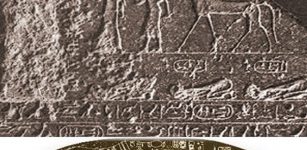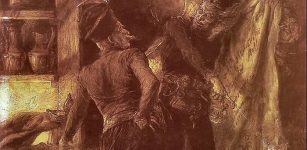Asenath And The Golden Tablet That Changed Her Destiny
Ellen Lloyd - AncientPages.com - There is virtually no information about Asenath in the Bible, but she was a woman of importance in ancient times. The story of Asenath is mentioned in the ancient manuscript Joseph and Aseneth. The text, written in Syriac, is a translation of older Greek writing, made around 550 CE by Moses of Ingila.
From this anthology that was compiled around 570 C.E by Zacharias of Mytilene (465 -536), who was a bishop and Christian historian, we get glimpses into the life of Asenath.
Did Joseph Marry An Egyptian Pagan Woman?
Contrary to his traditions, Joseph married an Egyptian woman. How and why did one of the most important Biblical figures mentioned in the Book of Genesis marry someone who was not a follower of his faith? Why and how could this union take place?
Joseph and Asenath. Illustration by Owen Jones from "The History of Joseph and His Brethren" (Day & Son, 1869). Credit: Public Domain
Asenath was the daughter of Potipherah, a priest from Heliopolis. According to the Biblical story, the current Pharaoh gave Asenath to Joseph to become his wife. The couple had two sons, Manasseh and Ephraim, and this made Asenath the mother of two tribes in Israel that founded the two royal dynasties.
In the story of Joseph and Asenath, the Egyptian woman is presented as a virgin who rejects several men in favor of Joseph, but he doesn’t want to have a Pagan wife.
To make herself worthy, Asenath locked herself in a tower. There, she rejected her idolatry in favor of Joseph's God, Yahweh. She was then visited by two angels who accepted her conversion, and she underwent a religious ritual. To remove the false prayers to the pagan gods, Asenath’s lips were covered with bees that stung her. When the ceremony was completed, she was allowed to marry Joseph.
A Golden Tablet Saved Asenath
Some scholars suggest Asenath’s life story is a bit more complex. Joseph, who was the son of Jacob, started his early years as a slave. Later, he became a man of great importance in ancient Egypt. Joseph was a vizier and the second most powerful man in Egypt, next to the Pharaoh.
So, it’s not so surprising that the Pharaoh offered him Asenath as a wife.
In The Hebrew Union College Annual, Aptowitzer explains that there is much more to Aseneth’s story. According to Aptowitzer, “there are three legends regarding Asenath: the legend of her decent, the legend of her deliverance of Joseph and the legend of her piety. The law of cause and effect was applied to the explanation of these three legends and resulted in the early combining of the legend of Asenath’s descent with that of her piety. Why was Asenath, who was brought up in Egyptian idol-worship, pious and upright? Because she was of the family of Jacob.”
Rabbi Pirkei de-Rabbi Eliezer suggested that Asenath was the daughter of Joseph's sister Dinah, conceived as a result of a rape by Shechem. Her brothers wanted to put her to death because illegitimate children were not tolerated in the house of Jacob. However, Jacob did not want to kill the newborn.
Asenath from Guillaume Rouille (1518-1589) - "Promptuarii Iconum Insigniorum". Credit: Public Domain
Aptowitzer explains that “Jacob, however, suspended around her a neck of golden lozenge on which he engraved the Holy Name and sent her (Dinah) away. Michael brought her to Egypt, where she (Asenath) was brought up in the house of the childless Potiphera.
When Jacob left Shechem, he wrote down the story of the violation of Dinah by Shechem on a golden tablet. When Dinah subsequently gave birth to Asenath, Jacob hung this tablet about her neck and exposed her near the wall of Egypt. On the same day, Potiphar was taking a walk, accompanied by his retinue, and approached the wall.
He heard the child weeping and commanded his followers to bring it to him. When he noticed the tablet and read the inscription, he said to his followers: “This child is the daughter of eminent people. Carry it to my house and procure a nurse for it.”. Thus she was brought up in his house.”
This story explains why Asenath, who was a Pagan, was nevertheless considered pious and upright. It was thanks to Jacob’s compassion that she survived. Her early life was dramatic, and the golden tablet that had been placed around Asenath’s neck was a birth certificate that changed her destiny.
Updated on June 21, 2021
Written by Ellen Lloyd – AncientPages.com
Copyright © AncientPages.com All rights reserved. This material may not be published, broadcast, rewritten or redistributed in whole or part without the express written permission of AncientPages.com
Expand for referencesChesnutt, Randall D. From Death to Life. Conversion in Joseph and Aseneth (Journal for the study of the pseudepigrapha: Supplement series 16). Sheffield: 1995
Aptowitzer, V. “Asenath, The Wife Of Joseph: A Haggadic Literary-Historical Study.” Hebrew Union College Annual 1 (1924): 239-306.
More From Ancient Pages
-
 Golden Figurine From Yozgat Depicts Unknown Hittite God
Artifacts | May 11, 2016
Golden Figurine From Yozgat Depicts Unknown Hittite God
Artifacts | May 11, 2016 -
 Magnificent Ancient Egyptian Gold And Soapstone Jewelry Discovered At Tell El-Amarna Necropolis
Archaeology | Dec 18, 2022
Magnificent Ancient Egyptian Gold And Soapstone Jewelry Discovered At Tell El-Amarna Necropolis
Archaeology | Dec 18, 2022 -
 Drought Was Not The Reason Cahokia, North America’s First City Was Suddenly Abandoned – New Study
Archaeology | Jul 4, 2024
Drought Was Not The Reason Cahokia, North America’s First City Was Suddenly Abandoned – New Study
Archaeology | Jul 4, 2024 -
 King Sanakht: Mysterious Ancient Egyptian Pharaoh Was A ‘Giant’ – Scientists Say
Archaeology | Aug 9, 2017
King Sanakht: Mysterious Ancient Egyptian Pharaoh Was A ‘Giant’ – Scientists Say
Archaeology | Aug 9, 2017 -
 Mysterious 70-Million-Year-Old Underground Village And Magnificent Tower Of Eben-Ezer In Belgium
Featured Stories | Mar 20, 2017
Mysterious 70-Million-Year-Old Underground Village And Magnificent Tower Of Eben-Ezer In Belgium
Featured Stories | Mar 20, 2017 -
 DNA Reveals Early Maya Trace Their Roots To Unknown Ancient Immigrants Carrying Maize From The South
Archaeology | Mar 22, 2022
DNA Reveals Early Maya Trace Their Roots To Unknown Ancient Immigrants Carrying Maize From The South
Archaeology | Mar 22, 2022 -
 Researchers Reconstruct Genome Of Centuries-Old E. Coli Using Fragments Extracted From An Italian Mummy
News | Jun 18, 2022
Researchers Reconstruct Genome Of Centuries-Old E. Coli Using Fragments Extracted From An Italian Mummy
News | Jun 18, 2022 -
 On This Day In History: Siege of Jerusalem: Titus And His Legions Breach The Middle Wall Of The City – On June 5, 70 CE
News | Jun 5, 2016
On This Day In History: Siege of Jerusalem: Titus And His Legions Breach The Middle Wall Of The City – On June 5, 70 CE
News | Jun 5, 2016 -
 Crop Circles: Are They Cosmic Messages That We Cannot Decipher?
Featured Stories | Mar 26, 2019
Crop Circles: Are They Cosmic Messages That We Cannot Decipher?
Featured Stories | Mar 26, 2019 -
 Ancient Urartu Settlement, Water Tunnel And Rock Tombs Found In Erzurum, Eastern Turkey
Archaeology | Dec 19, 2017
Ancient Urartu Settlement, Water Tunnel And Rock Tombs Found In Erzurum, Eastern Turkey
Archaeology | Dec 19, 2017 -
 Unexplained Mysteries Of The Superstition Mountains – A Gateway To Other Worlds?
Featured Stories | Dec 15, 2020
Unexplained Mysteries Of The Superstition Mountains – A Gateway To Other Worlds?
Featured Stories | Dec 15, 2020 -
 Nine Great Wall Beacon Towers Discovered In China’s Inner Mongolia
Archaeology | Apr 21, 2020
Nine Great Wall Beacon Towers Discovered In China’s Inner Mongolia
Archaeology | Apr 21, 2020 -
 Polynesian Stonehenge: Enigmatic Ha’amonga ‘a Maui Trilithon Of Tonga
Civilizations | Sep 11, 2018
Polynesian Stonehenge: Enigmatic Ha’amonga ‘a Maui Trilithon Of Tonga
Civilizations | Sep 11, 2018 -
 How Did Canada’s Oldest Coin Make Its Way To Newfoundland’s South Coast?
Archaeology | Nov 14, 2022
How Did Canada’s Oldest Coin Make Its Way To Newfoundland’s South Coast?
Archaeology | Nov 14, 2022 -
 Kingdom Of Mitanni: Forgotten For Millennia But Once Great Power Of Ancient West Asia In 2000 BC
Civilizations | Jun 20, 2023
Kingdom Of Mitanni: Forgotten For Millennia But Once Great Power Of Ancient West Asia In 2000 BC
Civilizations | Jun 20, 2023 -
 Deeper Look Into Chinese Swords Throughout The History Of The Dynasties
Featured Stories | Sep 19, 2018
Deeper Look Into Chinese Swords Throughout The History Of The Dynasties
Featured Stories | Sep 19, 2018 -
 Reconstrucion Of The 19-Meter-Long Gjellestad Viking Ship In Progress
News | Oct 9, 2023
Reconstrucion Of The 19-Meter-Long Gjellestad Viking Ship In Progress
News | Oct 9, 2023 -
 Pitted Ware Culture – Neolithic Scandinavians Used Skin Boats To Trade And Travel Across Large Distances
Archaeology | Sep 11, 2024
Pitted Ware Culture – Neolithic Scandinavians Used Skin Boats To Trade And Travel Across Large Distances
Archaeology | Sep 11, 2024 -
 Ancient Stela Of Piankhi – King Of Napata, Rightful Ruler And Maintainer Of Maat
Featured Stories | Apr 25, 2018
Ancient Stela Of Piankhi – King Of Napata, Rightful Ruler And Maintainer Of Maat
Featured Stories | Apr 25, 2018 -
 Pan Twardowski – The Man Who Sold His Soul To The Devil In Exchange For Special Powers
Featured Stories | Aug 12, 2021
Pan Twardowski – The Man Who Sold His Soul To The Devil In Exchange For Special Powers
Featured Stories | Aug 12, 2021


